| January | February | March |
| April | May | June |
| July | August | September |
| October | November |
Wednesday, 29 November 2017

An autumn flowering snowdrop, Galanthus 'Potter's Prelude'
Thursday, 21 November 2017
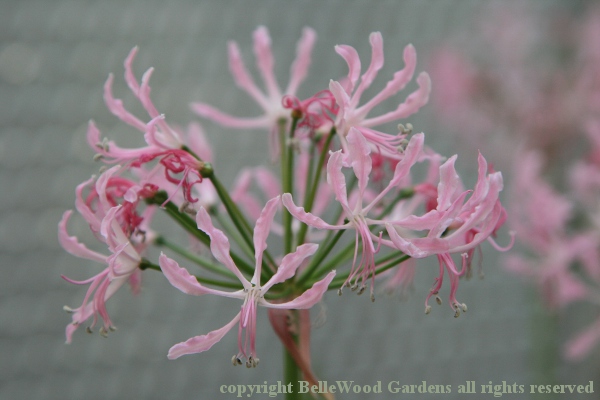
And in the greenhouse, a nerine. Can you tell I love bulbs?
Wednesday, 15 November 2017

Wooden covers now in place over cut back and tubbed bananas.
Sunday, 11 November 2017

There was a frost last night. So much for
the cannas. Time to cut back and move in.
Wednesday, 8 November 2017

Enkianthus in first stage of autumn color. It will become red.
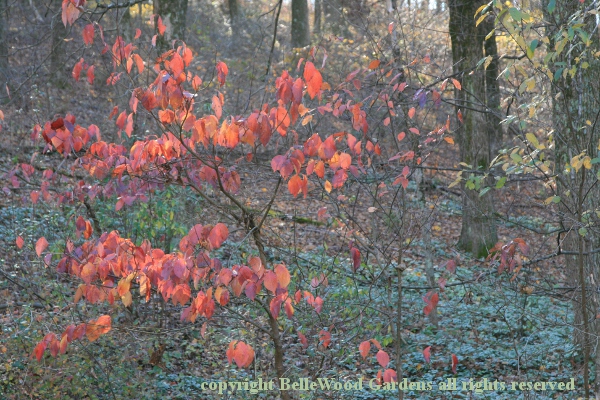
Which flowering dogwood, Cornus florida, has already achieved.
31 October 2017
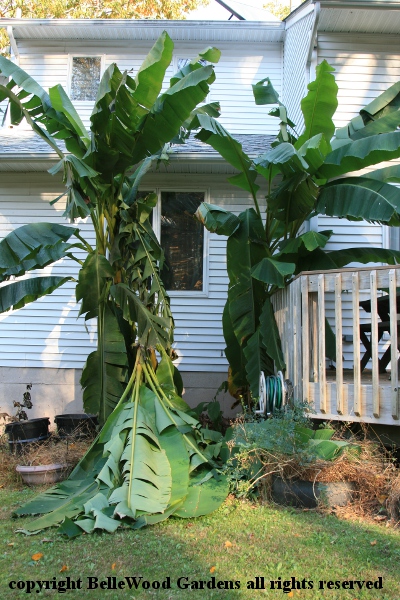
Storm came through and, as you can see,
the bananas took a beating. It's late enough

that I'll cut them back and cover with tubs filled with dry leaves.
16 October 2017
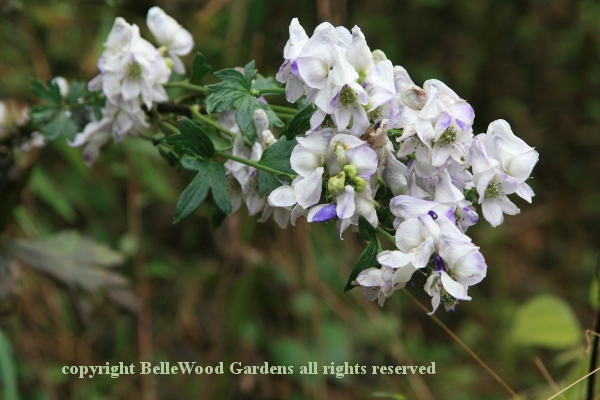
Aconitum 'Cloudy' with hint of blue, off-white flowers.
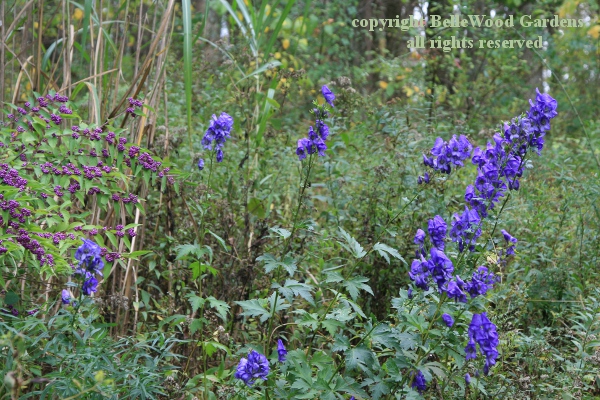
Very different from the typical rich blue of Aconitum napellus,
here paired with the very purple fruit of Callicarpa dichotoma.
12 September 2017
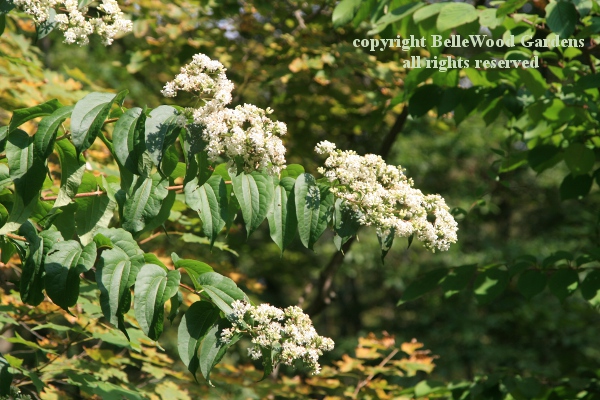
Seven sons, Heptacodium miconioides. Found in 1907, named
in 1916, languished in obscurity until viable seed was collected
in 1980. Propagates from cuttings too. And butterflies love it.
3 September 2017

Certainly hardy in the garden, but I enjoy keeping these pots of
Cyclamen hederifolium in the greenhouse for closer enjoyment.
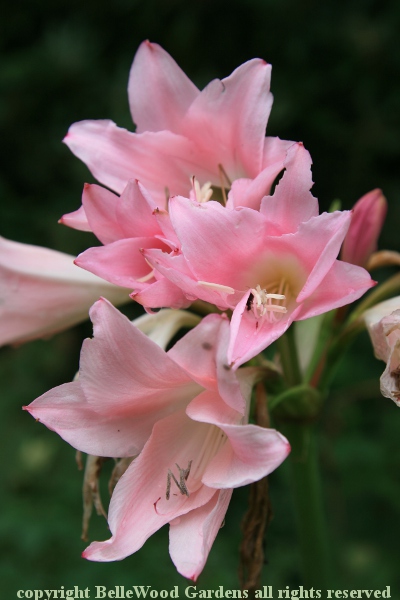
What most people call "amaryllis" is not. Those bulbs with huge showy flowers around Christmas time are more accurately given the Latin name of Hippeastrum. There is a bulb correctly named Amaryllis belladona. Originally from the Cape region of South Africa, very happy in southern California. This is a hybrid of the true amaryllis and a crinum, so it's proper Latin name is ×Amarcrinum.
14 August 2017
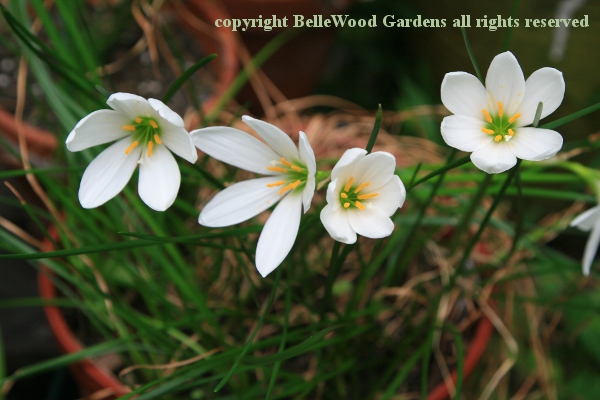
This water loving little bulb is Zephyranthes candida. Alas, not hardy.
13 August 2017
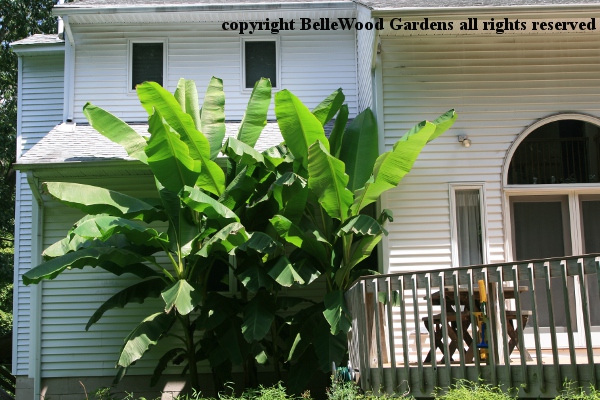
My bananas are really having a good season this summer.
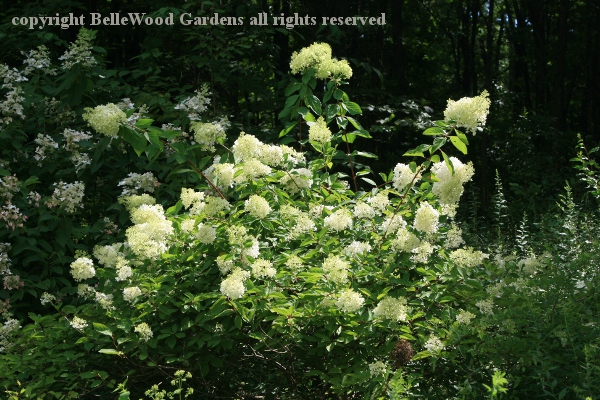
Pleasant to have shrubs like this Hydrangea paniculata that
flower in summer. But only once, not repeating as do roses.
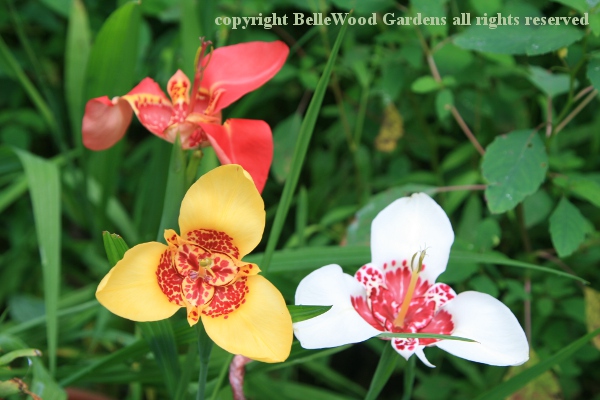
The tigridia continue to open more flowers, very good since
each one last only for a day. And I've noticed some variations.

The red tigridia are not all exactly the same shade of red.
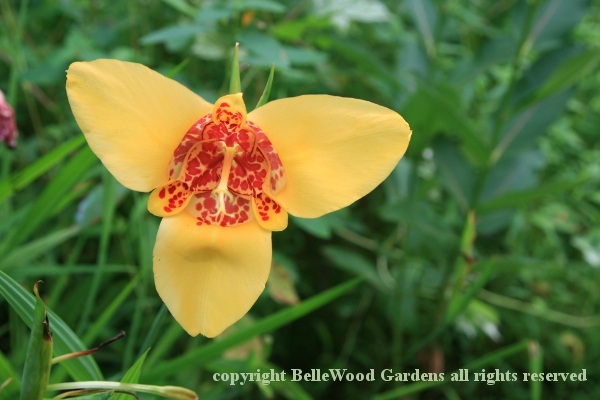
Ditto for the yellow ones. And the amount of red speckling is
also variable. Small variations teach me to look more closely.
Saturday, 22 July 2017

The tigridia I bought at a big box store were
25 each red and yellow. Delightfully enough,
two are white. I need to tag them, somehow.
Thursday, 13 July 2017

Like Vulcan's forge, the glowing hot heart of Hemerocallis 'Africa'
seems to burn against the dark burgundy velvet of the petals.
Monday, 10 July 2017

Wonderful for bees and butterflies - Asclepias syriaca, milkweed.
This year, for the very first time ever, I noticed deer damage.
Why eat something with glucosides in the milky, sticky sap.
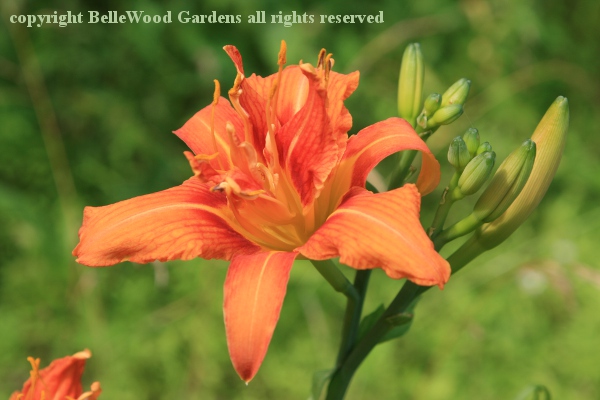
Tawny daylilies up and down the roadsides. This, in my garden,
is the double flowered form, Hemerocallis fulva 'Kwanso'.

Red flowered form of the tiger flower, Tigridia pavonia 'Rubra'.

I meant to repot Eucomis pole-evansii this year. But it insisted
on springing into growth while still down in the basement, before
I got around to it. Would I have split the two bulbs? Don't know.
Sunday, 9 July 2017
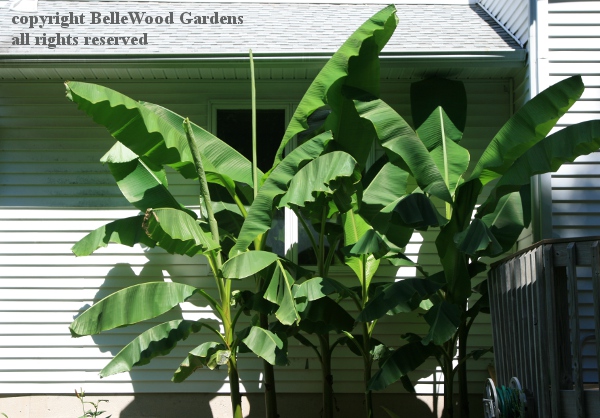
It is July 9th, and my bananas are enjoying summer heat and rain.
Go here for more details.
Saturday, 8 July 2017

Rain lilies, Habranthus robustus, have
hurled themselves into bloom.
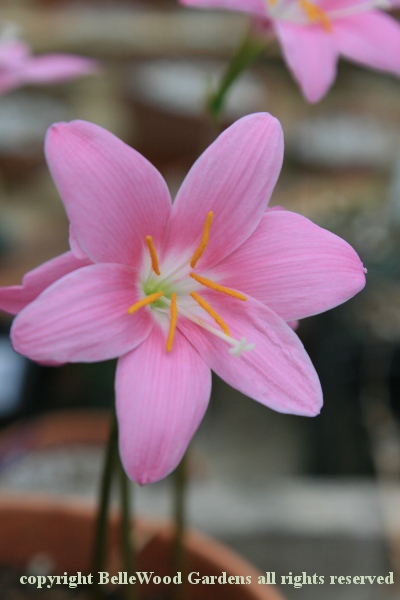
They magically spring into flower
just days after rain (or watering.)
Thursday, 6 July 2017
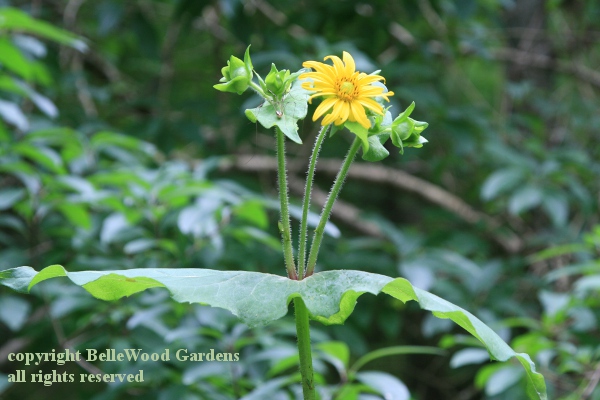
Silphium integrifolium connatum, commonly named cup plant
because of the way the stem appears to pierce the merged leaf,
creating a small depression which actually holds rainwater.

Lilium 'La Reve' has been growing in a half-barrel size
plastic container at the bottom of the driveway
for a number of years. Winters over just fine, too.
Wednesday, 5 July 2017

In its native Mexico this flower is called el tigre, not for tiger
but for jaguar. Tigridia pavonia 'Aurea' is easy to grow.
Fantastical flowers last for just a day but are numerous.

Sigh. Plant names do get changed. Is this
Hymenocallis or is it Ismene? Confusing.
Saturday, 1 July 2017

Crinum have sizable bulbs, and elegant flowers.
Here at BelleWood Gardens they perforce must
grow in pots. Our winters are too cold for them.
Monday, 26 June 2017
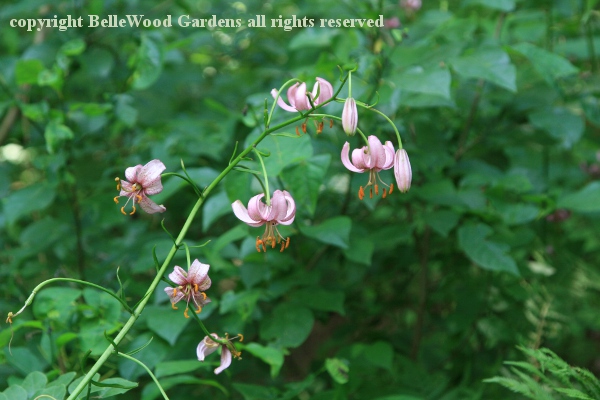
Tall and stately, Lilium martagon has small flowers
that impress with their numbers and attractive appearance.

.

Sauromattum guttatum is another of those
stinky aroids successfully pollinated by flies.
Saturday, 17 June 2017

It was a few years ago that I planted a couple of Digitalis lutea
on this slope. I think you'll agree that they are happy here.
Wednesday, 14 June 2017

Lilium martagon 'Album' is a favorite, with its sturdy white petals
curved into a tight Turk's cap, embellished with golden pollen.

.

Iris 'Black Gamecock' has rich, velvety purple petals and a streak
of gold to guide pollinating insects to the pollen / nectar "pantry."
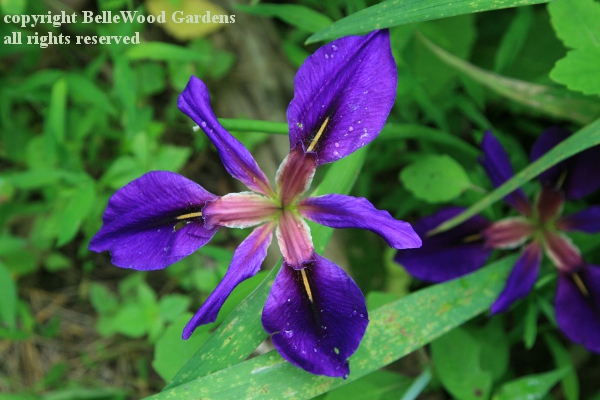
.

Sweetshrub, Calycanthus floridus 'Hartledge Wine'
has exceptionally large pomegranate red flowers.
Sunday, 4 June 2017
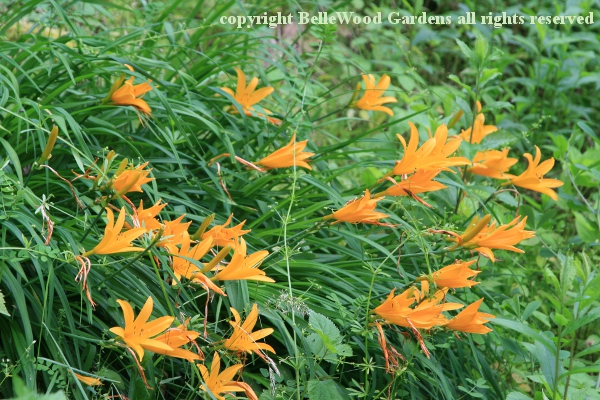
A patch of cantaloupe colored daylilies, label lost but flowers
still brighten an overcast day in early June.

Digitalis lutea just coming into flower.
It freely seeds itself up and down the slope.
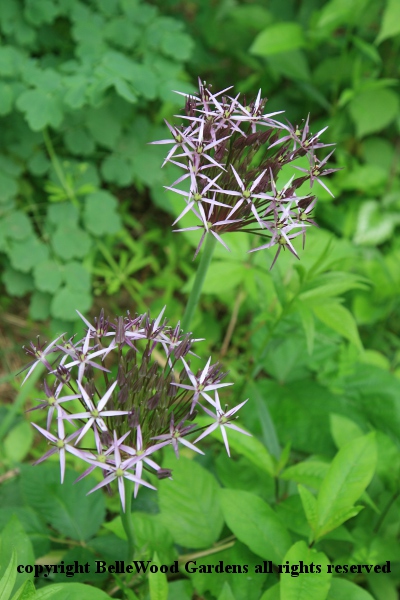
Every year Allium christophii always surprises me
when suddenly its metallic purple umbels appear.

Ditto for this giant purple ornamental onion. It could be
'Lucy Ball', or maybe 'Rien Poortvliet' . . .
I know I planted both cultivars, once upon a time.

The peonies continue to enchant me. This beautiful delicate pink

softly shades from cream with a tinge of pink to satiny pink.
Friday, 2 June 2017

The intersectional peonies are in flower. I bought them at a big box store
a couple of years ago, quite inexpensively as they were finished blooming.
Gardeners are always looking ahead to next year. I could wait - worth it!
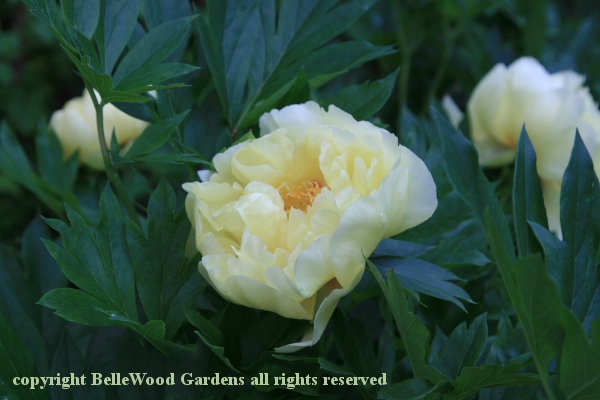
Wednesday, 24 May 2017
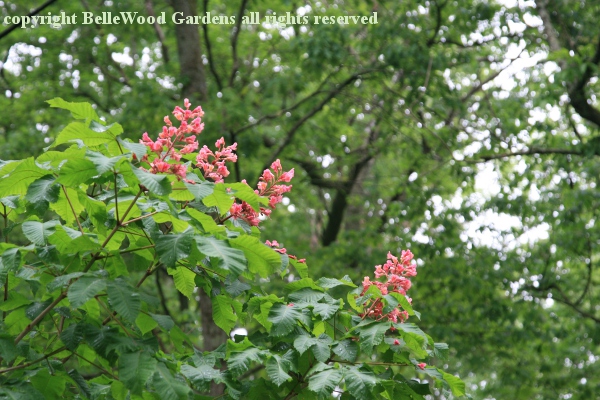
Red buckeye, Aesculus pavia, that I raised from seed. Another of
the "moved from Connecticut in wardrobe cartons" when
all our chattel goods (and some plants) came to New Jersey.

Fringe tree, old man's beard, Chionanthus virginicus has a lovely mist
of white flowers. Still don't know if I have male, female, or both -
which are necessary if there are to be any olive-shaped blue fruits.

Dame's rocket, Hesperis matronalis is a pretty, non-native flower.
Not quite a weed but still, quite generous about re-seeding.

Just three days later and the banana has
impressively unfurled its leaf.
Sunday, 21 May 2017
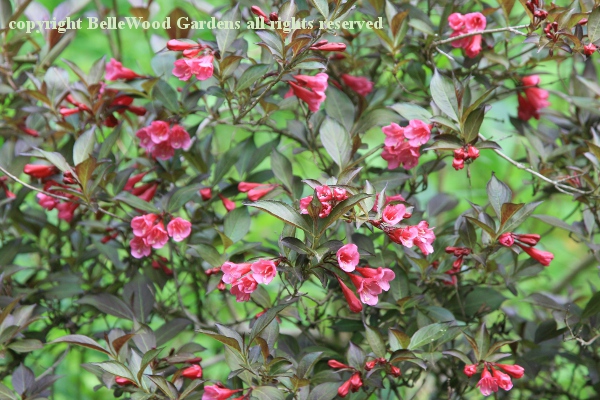
I like plants that pay their rent with more than a brief period
of bloom. Weigelia 'Wine and Roses' has attractive foliage
as well as vibrant flowers, even more vivid against dark leaves.

Spreading over the hillside, deer do not dine on this doronicum.
And I never see leopards, so leopard bane is a good common name.

A nameless soft blue bearded iris with that
delicious floral fragrance that some iris have.
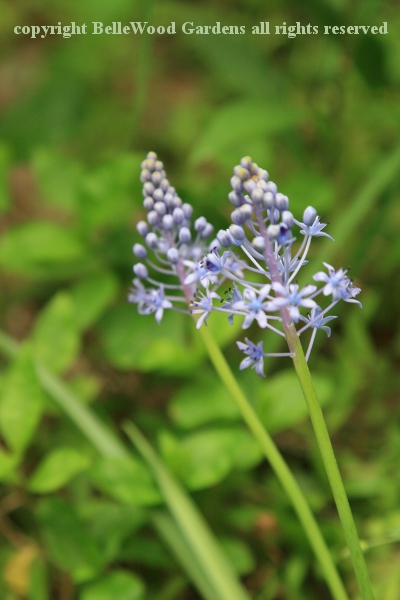
I remember when I collected Scilla litardierei
from an abandoned garden across the river
in Pennsylvania. Now at home, blooming here.

Creamy white Camassia leichtlinii, native
to the Pacific Northwest grasslands.

Columbines easily re-seed. And since I only have one color form
the seedlings look the same. (Columbines are quite promiscuous.)
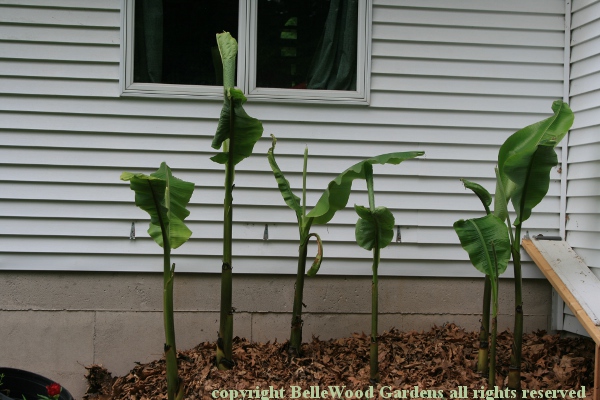
Looks like I'll have a veritable grove of bananas.
Saturday, 20 May 2017

What's this tapping at my study's window?
The hardy bananas are again in growth!
Thursday, 4 May 2017
Yes, May the Fourth be with you.
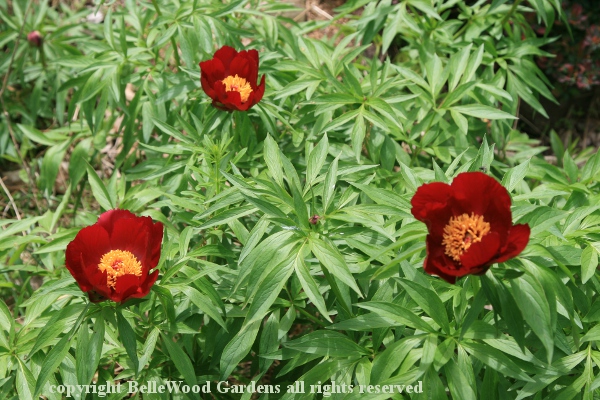
An early flowering hybrid with the fern leaved peony,
Paeonia 'Early Scout' is modest in size, bold in flower.

.

It really is a handsome shrub and the fuzzy
indumentum under the leaves helps discourage deer.
Monday, 1 May 2017
What's in bloom in BelleWood Gardens on this the merry first day of May
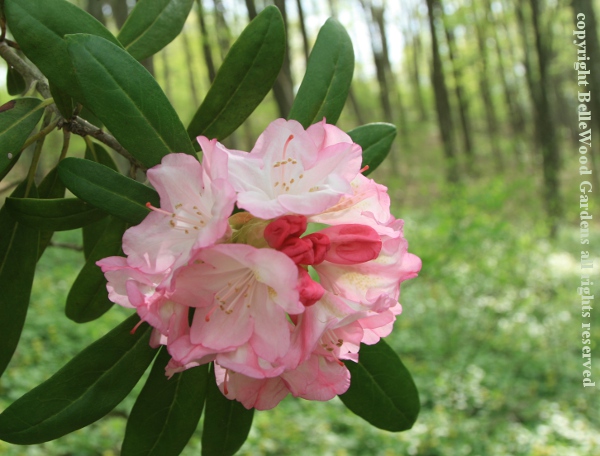
I remember when the wardrobe carton with this
Rhododendron yakushimanum came off the moving truck
from Connecticut. First things first, it had priority.

A handsome, unusual Japanese jack in the pulpit,
Arisaema thunbergii urashima

.
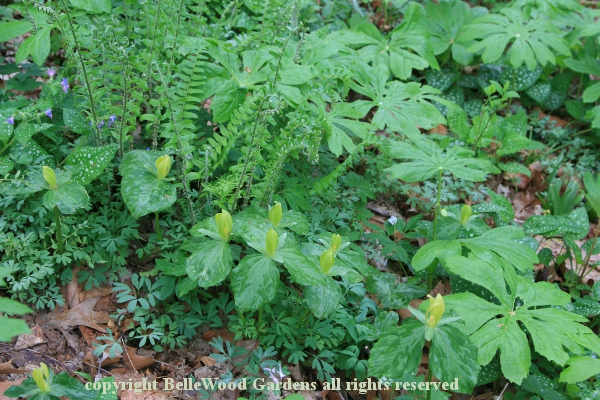
Trillium luteum continues its attractive display.

Bleeding heart, Dicentra spectabilis. Perchance have you read
the simple folk tale about it? Here's my version of the legend.
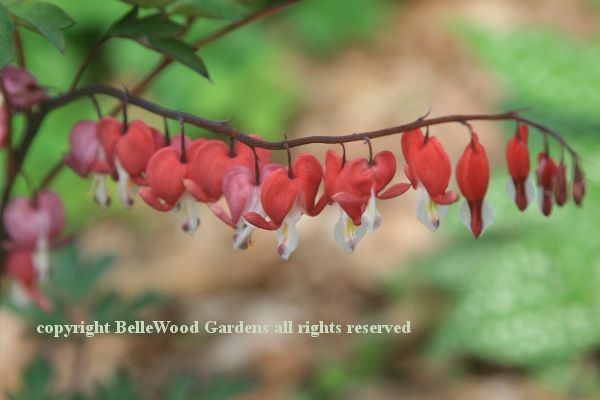
'Valentine' is a D. spectabilis cultivar with deep red flowers.

Soft pink flowers scattered among the unspotted leaves of
Pulmonaria montana, formerly named P. rubra.

Paeonia japonica is flowering quite well. Many seedlings
that I've scattered here and there are now flowering size. Nice!
This year May is somewhat on the cool side. Still keeping some plants in the greenhouse.

Some of the Hippeastrum are determined to bloom. Now! So 'Charisma' is doing its thing. I've had it for years and years.
Outdoors in summer, potted, never watered in winter and kept in the basement. And then at some point the grow imperative starts up and there's nothing to do but move the pots into the greenhouse.
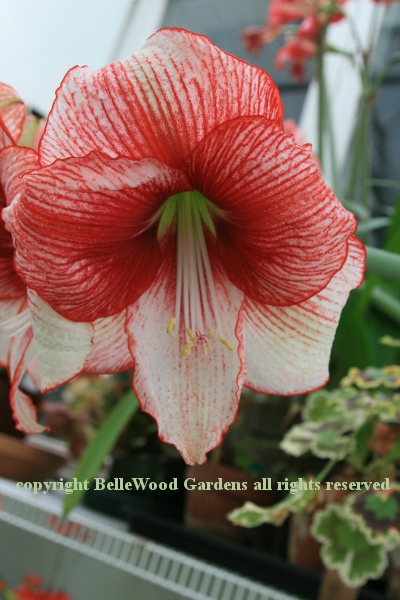
.

'Appleblossom' is another that insisted it is time to get growing.

And the ephiphyllum is in flower too.
Saturday, 22 April 2017
Overcast and drizzle today, so I'm looking for flowers in my greenhouse.

I think the white ones are more fragrant but
I really like the color of Freesia 'Mercurius'

No label. This Hippeastrum makes offsets that
soon reach flowering size. Very charming.

Now that there's more and stronger sunlight
Pelargonium 'Vancouver Centennial' shows
more color in the leaves, and more flowers also.
Friday, 21 April 2017
Five days. Just Monday to Friday, and I have more to show you.


Masses of Helleborus xorientalis that have been seeding and spreading about.
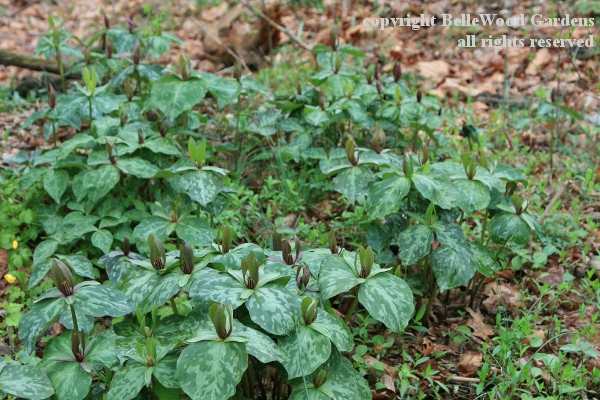
Delightfully enough, the same is happening with these sessile trilliums.

I think an attractive combination pairs them with
Athyrium nipponicum 'Pictum', Japanese painted fern.

There are only a few of the deliciously citrus scented Trillium luteum. Given time, ants will spread their seed about. Myrmecochory, it's called. Trillium coax the ants to do this with an elaiosome, a sticky little growth high in lipids and proteins on the seed. The ants carry off the whole seed, eat the elaiasome, discard the seed which then gets to sprout somewhere other than right by the parent plant. It means that if I want to collect the seed to sow it myself I must enclose the capsule with fine mesh lest ants chew through the side and gallivant off with the seeds. Bloodroot, Sanguinaria canadensis, uses this dispersal mechanism also, as do some other plants.

Trillium grandiflorum goes from strength to strength.
Now there are several flowers open rather than only one.
Another couple of narcissus are now in flower.

Still do not know who the misidentified little pink daffodil is
but I am quite sure that this is Narcissus 'Foundling'.

And I'm also quite sure I have absolutely no idea who this is.
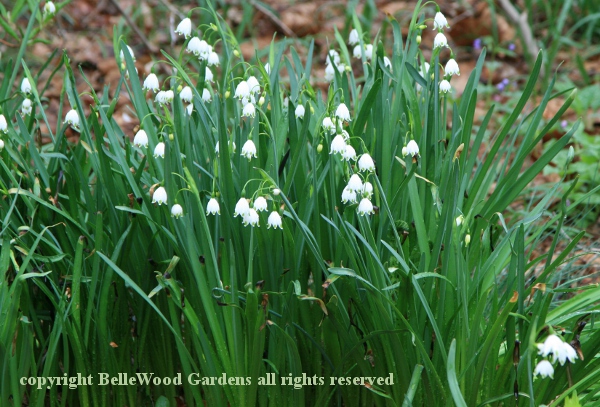
Summer snowflake, Leucojum aestivum. Definitely later than
the spring snowflake, L. vernum. Definitely not summer either.

A wonderful, easy to grow, vivid fuchsia pink primrose, Primula kisoana.
Native to Japan, it has thread-like underground runners that help it spread.

It's overcast and drizzling today so the intensely yellow flowers of
Hylomecon japonicum are furled and drooping. Got to keep the pollen dry.

Intensely blue. That's the typical color of Virginia bluebells, Mertensia virginica.
Buds are a slightly muddy pink that clears to sky blue when the flowers open.

But every now and then I find there's a Virginia bluebell
that didn't read the book. Virginia pink bell, anyone?

Some plants go for leaves in a color other than basic green.
Brunnera 'Jack Frost' has silvery leaves netted with green.
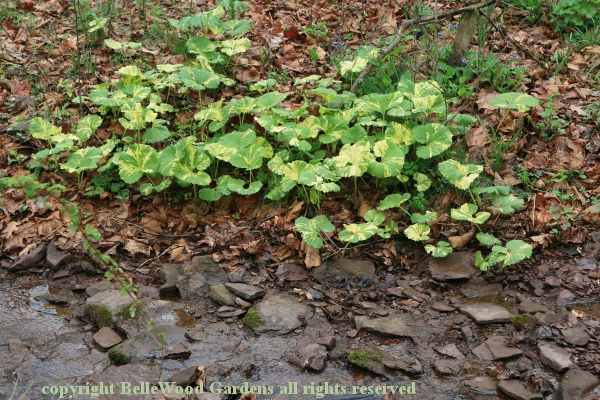
While Petasites japonicus 'Variegatus' has leaves
blotched and sectored in creay yellow.
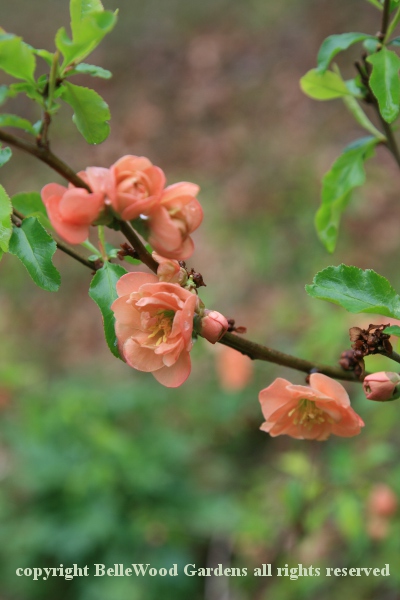
Shrubs are flowering too. Cydonia 'Cameo' has
warm pink flowers, nicer than the typical brick red.

This is Cercis chinensis, the Chinese relative of
our native Judas tree, Cercis canadensis.
Monday, 17 April 2017
One week of warm (exceptionally warm) weather has herbaceous perennials
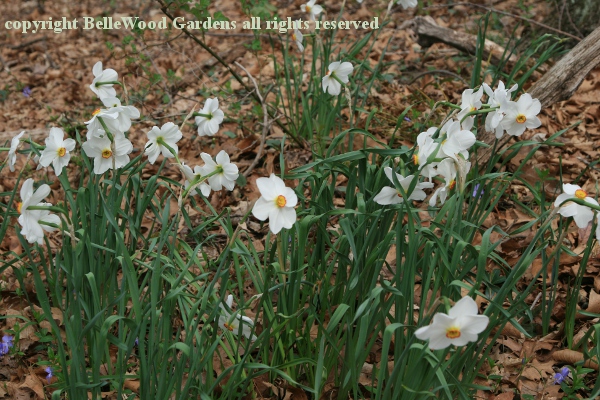
just hurling themselves into flower. Who expects 86 degrees Fahrenheit
(that's 30 Celsius) on 16 April? Along the Forest Deck path are several cultivars
of Narcissus poeticus such as 'Old Pheasant Eye', 'Cantabile', and 'Felindre',
and also subspecies recurvus. Labels long gone, no idea which is which.

No matter, all are lovely and rather, in fact extremely, similar.
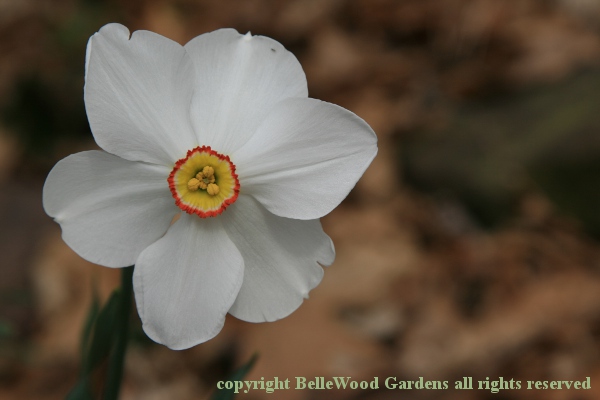
Their parent species is prepotent so all have crystalline white petals
and a ruffle of a cup banded green / yellow / orange red. So beautiful.

Another beauty is Narcissus 'Polar Ice' which opens
white and ivory, then fading to all white.
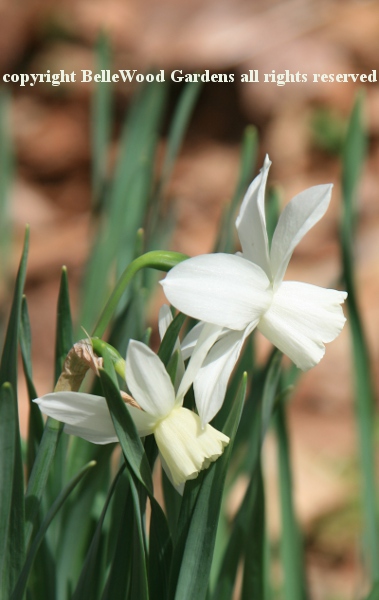
Dating back to 1916, Narcissus 'Thalia' is a favorite of mine.
Two or 3 white flowers on each stem. Reliably perennial too.
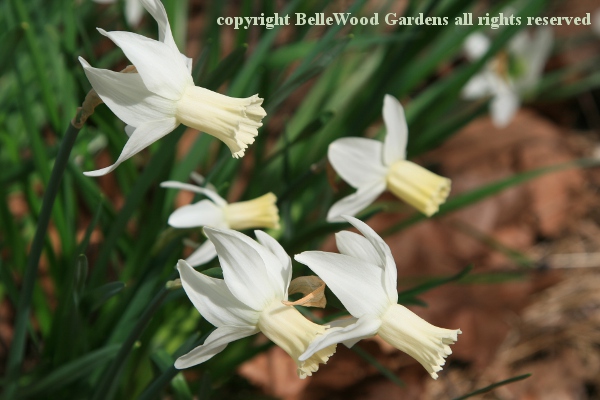
There's some confusion here, due to vanishing labels. I think
that the above daffodil is 'Dove Wings' and below is 'Jack Snipe'.
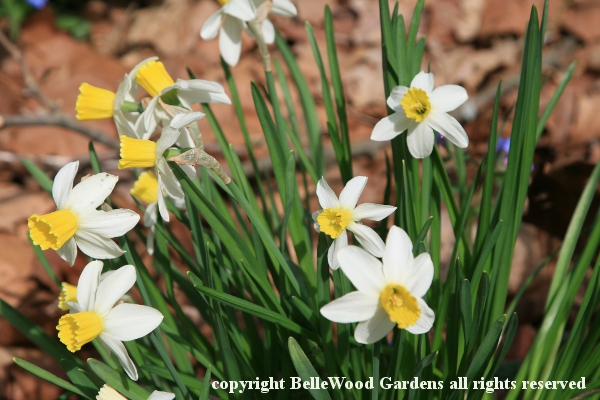
Let's skip the issue and look at other bulbs, shall we?

Such as Hyacinthus 'Woodstock' with its rich, wine red flowers.

Or the appealing little snake's head fritillary, Fritillaria meleagris,
also known as Guinea hen flower, chequered lily, and leper's lily.

The dried out little tubers that are planted in autumn give no clue
to the pristine white flowers Anemone blanda 'White Splendour'
(another daisy look-a-like) so generously produces in Spring.
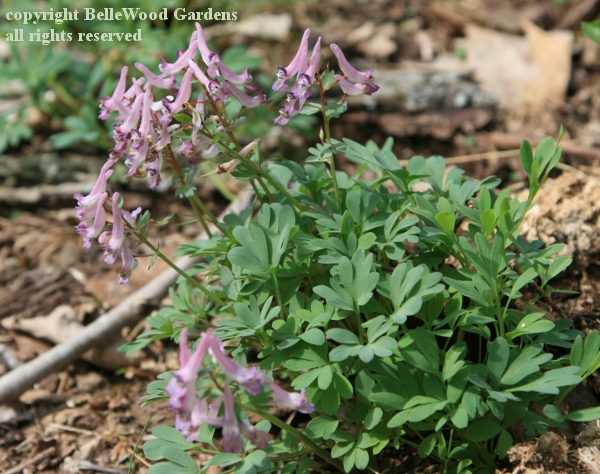
Fumewort, Corydalis solida, increases prolifically. No problem,
for like a quickly departing house guest it is soon dormant.
Used loosely, "bulb" refers to a plant's underground storage structure. To a botanist there are several different lumpy underground food storage structures: true bulbs such as daffodils, lilies, and onions; corms such as crocus and gladiolas, and tubers such as winter aconites. "Native" is the term specific to indigenous origin or growth. The Netherlands propagates and sells bulbous plants native to many different countries. There are bulbous plants native to the United States.

Trillium, for example. Perhaps best known is Trillium grandiflorum.
It is a pedunculate trillium, with a stem between flower and foliage.
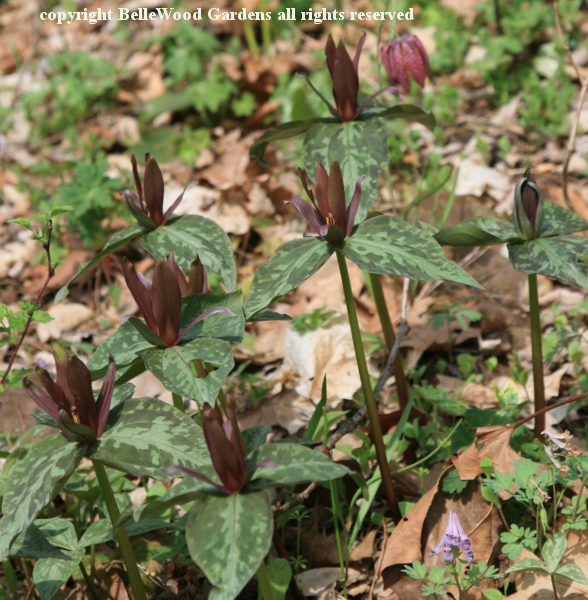
Trillium cuneatum. The flowers of sessile trilliums sit directly on the leaves.
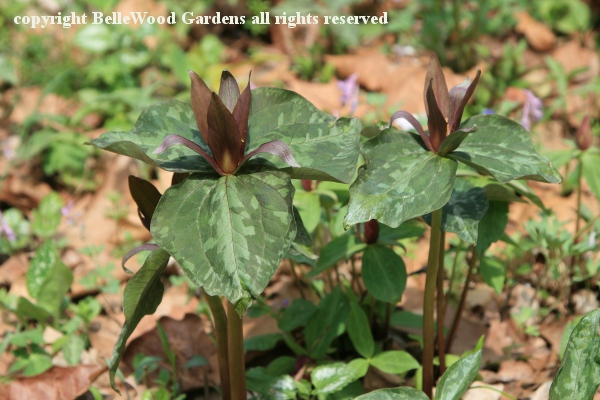
Trillium are so named for the whorl of three leaflets. "Why," my friend Ed Leimseider
used to ask, "if lilium are called lilies, why aren't trillium called trillies?" Funny man.
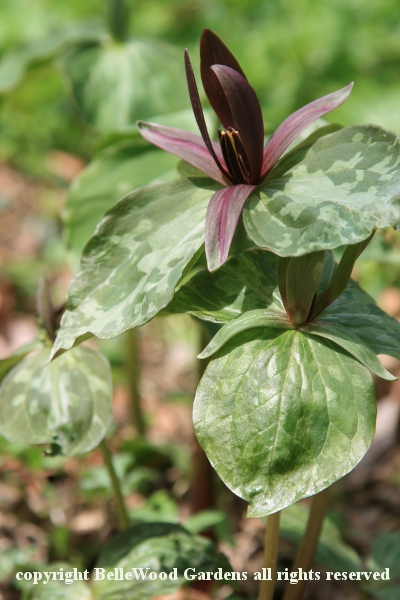
Trillium sessile, a portrait.
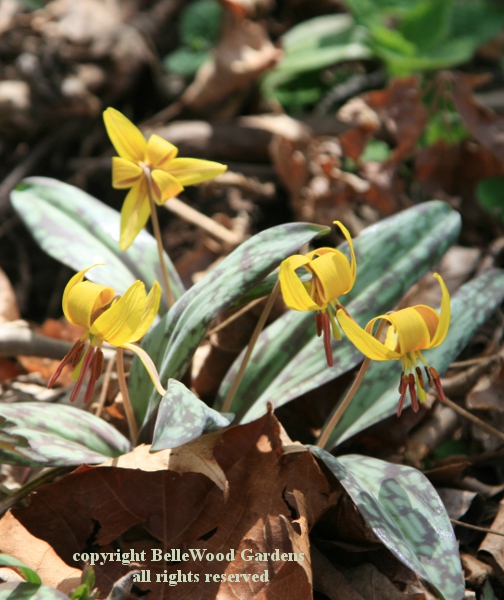
Our native dogtooth violet, Erythronium americanum.
The bulb must grow a pair of leaves, only then it will bloom.

Common and Latin name both acknowledge the orange-red sap
of bloodroot, Sanguinaria canadensis. This is the enchanting
fully double form 'Multiplex' also known as 'Flore Pleno'.
On to the herbaceous perennials.
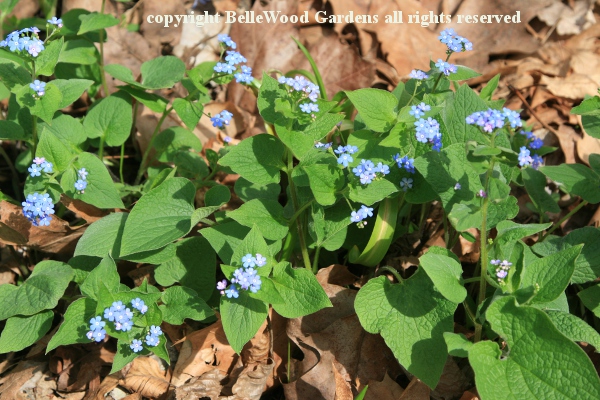
This one has had a name change. Once upon a time it was known as
Anchusa mysotidiflora, anchusa with forget-me-not like flowers. Now
it is called Brunnera macrophylla, brunnera with very large foliage.

Lesser celandine, Ranunculus ficaria wants to cover my garden.
I loathe it, as my use of herbicide indicates. But I do grow three cultivars.
This green centered double is Ranunculus ficaria 'Bowle's Double'
The Doctrine of Signatures, which dates back a very long time to Dioscorides (born 40 A.D., died 90 A.D.) and Galen (born 129 A.D., died 216 A.D.), states that herbs resembling various parts of the body can be used by herbalists to treat ailments of those body parts. Someone decided that the spotted leaves of lungwort, Pulmonaria saccharata, were an indication it was useful for lung problems. Keep in mind that this medicinal use came well before Linnaeus (born 1707, died 1778) and his grand idea of binomial nomenclature. Regardless, the various lungwort species and cultivars make handsome additions to the woodland garden.
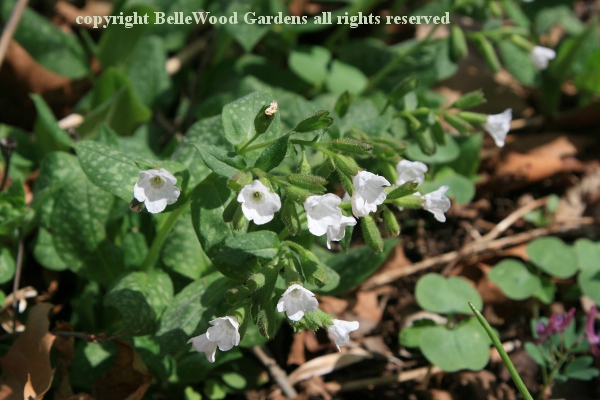
Pulmonaria 'Sissinghurst White' is a cultivar with very attractive, clean white flowers.
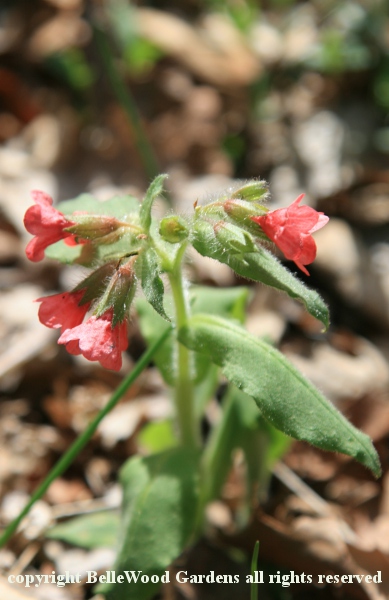
And then there's Pulmonaria rubra,a species with rose pink flowers.
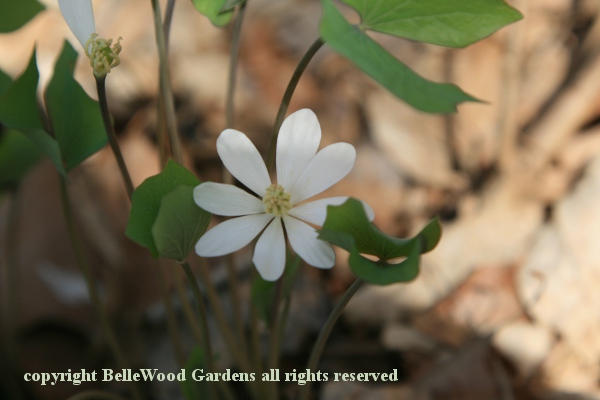
Last week I posted an image of Jeffersonia dubia. All of them have
dropped their petals. And this is the last flower I found of J. diphylla
Oh well, with luck they'll both make lots of seed and scatter it about.
Monday, 10 April 2017

Narcissus 'Ice Follies' is popular for several good reasons.
It's beautiful, reliable, and deer and voles leave it alone.
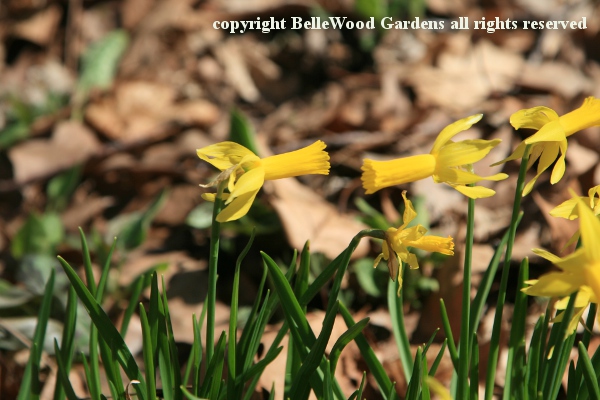
Narcissus cyclamineus is a species daffodil, named for its swept back petals
resembling those of cyclamen. It's a required parent for Division 6 daffodils.

One of the beautiful blues. Grecian wind flower, Anemone blanda, is sturdy,
reliable, easily grown from a little tuber. Not a daisy even if it looks like one.

Bloodroot, Sanguinaria canadensis. Another looks-like-a-daisy-but isn't.
Named for its orange red sap. A native plant with quickly fading flowers.

Jeffersonia dubia is a Manchurian "cousin" of a native plant. Difficult
to establish, easily grown once you manage this, even self-sowing.

Japanese dogtooth violet, Erythronium japonicum, grows well but
does not seem to self-propagate.
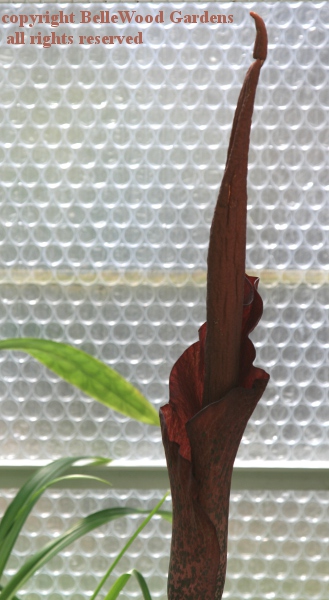
And in the greenhouse, Amorphophallus. Such a stench! As soon
as I had this image I cut it down and tossed in the compost heap.
Thursday, 30 March 2017

Little golden yellow daffodils, mini-me of the popular big standard ones.

Scilla bifolia, happily multiplying and scattering
dainty true blue flowers across the garden.
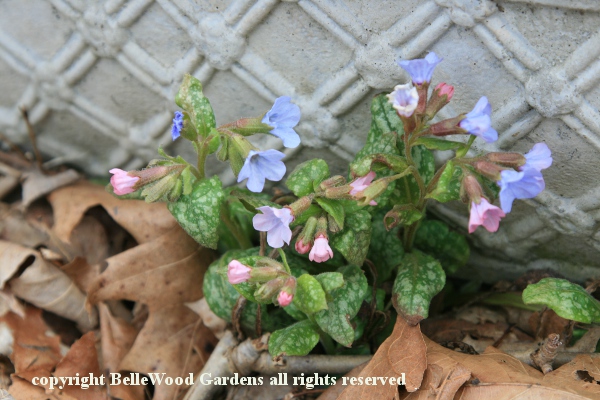
Latin name, common name. Pulmonaria saccharata, lungwort.
It once was thought that by the Doctrine of Signatures
the speckled leaves appearance mean they were good
for treating diseases of the lungs - catarrh, pneumonia.

Christmas rose, Helleborus niger, present their snow white flowers.
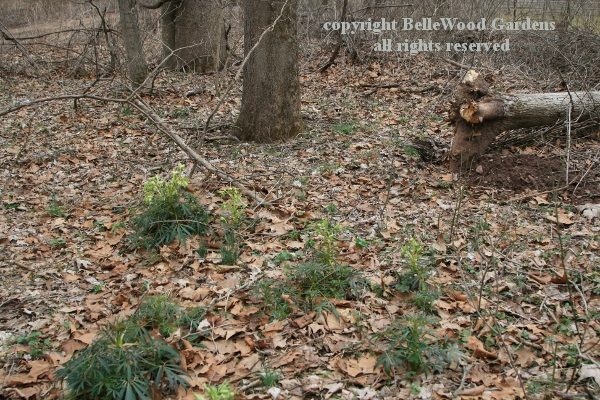
One of our heavy rainstorms must have washed these Helleborus foetidus
through the culvert and across the road. I went with bucket and spading fork
and brought them home again.

Petasites japonica is sending up its bouquets of green flowers.
Wednesday, 29 March 2017

Snow goes and up come flowers. You have your choice of names
for this pretty thing - Bulbocodium vernum or Colchicum vernum,
It does have a colchicum-like corm and vernal, appears in Spring.
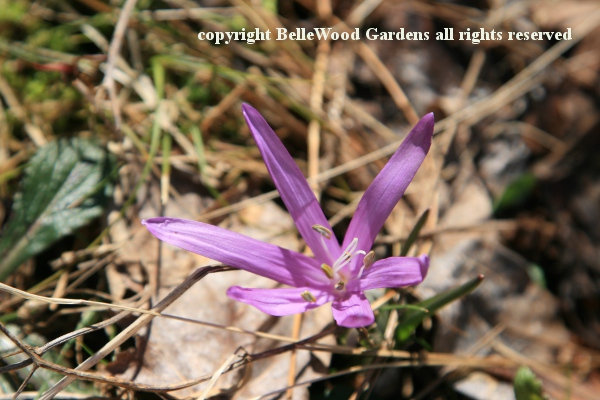
Sunday, 26 March 2017

Crown imperial, Fritillaria imperialis, emerges when weather is often quite chilly. Its tall growth becomes droopy with frost but straightens up with better weather. This time they were just emerging when a mid-March snow was dumped on them, becoming wet and icy. They now look somewhat stunted. We will see what happens.
Saturday, 25 March 2017
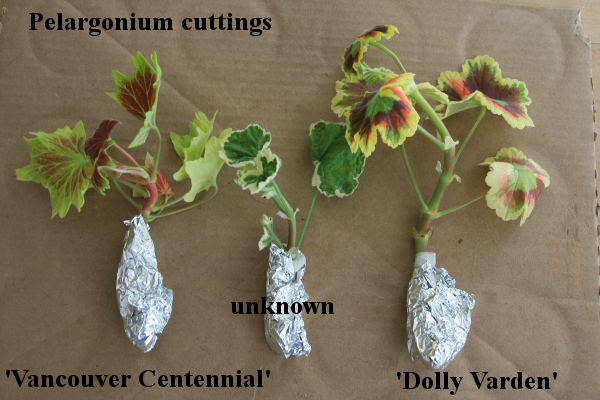
The Tohickon garden club had a talk on interesting annuals. In keeping with the topic members were asked to bring either something kept over the winter or annuals just started from seed. I didn't want to haul in three pots of pelargoniums so brought cuttings instead.
Sunday, 19 March 2017

The greenhouse continues to delight me. Lachenalia pustulata
with cat whisker stamens and bumpy leaves makes a handsome display.

A white freesia perfumes the greenhouse.
Wednesday, 8 March 2017

It's definitely not Christmas, and surely not a rose, but Christmas rose
is the common name. Helleborus niger is not much help either, unless
you have X-ray vision to observe its black roots. Wonderful flowers.
Update: 9 inches of snow and cold temperatures on 14 March. Two weeks later
snow is gone and the hellebores seem to have successfully emerged & recovered.
Saturday, 25 February 2017

The greenhouse, too, continues in floriferous style.
Here's Lachenalia 'Rupert'. Love the luminous hues.

Not peculiar snowdrops. These are snowflakes, Leucojum vernum.

One of the variations that galanthophiles love to love. Notice
the green tipped petals. Aptly named, this is
Galanthus 'Virid-Apice'. Or maybe 'Viridapice'.
Authorities have opinions. Which vary.

Helleborus orientalis subsp. abchasicus Early Purple Group is a very specific type of hellebore, noticeable for plum purple flowers with conspicuously contrasting ivory yellow stamens, and red-tinged foliage when it first appears. Looking back, the earliest appearance of these hellebores in the Early Purple Group here at BelleWood Gardens was January of 2007. There are a couple of other years with February flowering, some in March, and one outlier in April. Keep in mind that the photographs were not necessarily taken on the first day the flowers opened. Also, hellebore flowers look good for a long time.
Here they are paired with the soft lavender flowers of Crocus tomasinnianus.
Thursday, 23 February 2017
Peculiarly warm weather continues.
I mean, come now, today's high temperature of 66 degrees Fahrenheit is not typical of February.

Common snowdrop, Galanthus nivalis is now scattering its flowers
amongst the tapestry of last year's fallen brown leaves.

Galanthus 'Atkinsii' displays its very long petals.
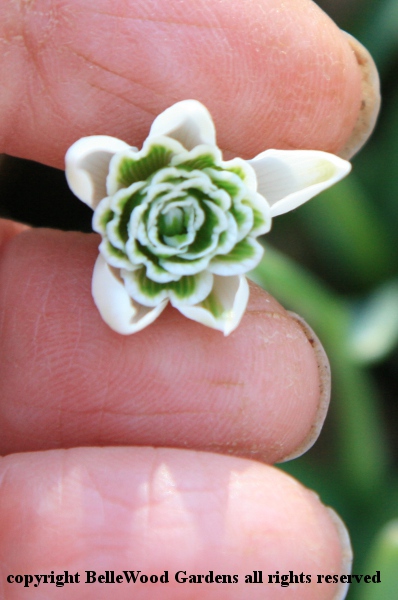
While Galanthus 'Hill Poë' must be coaxed
into revealing its very double center.
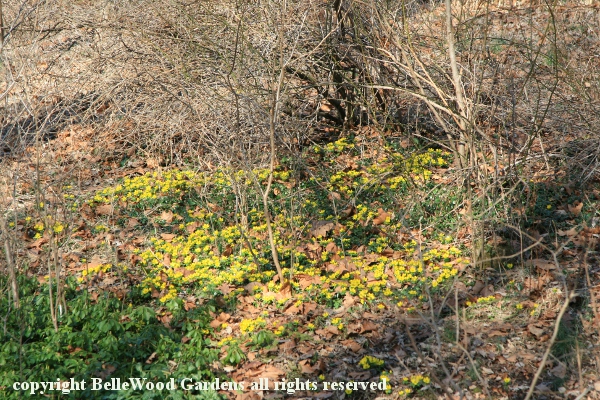
Winter aconites, Eranthis hyemalis, in profusion

attracting the attention of nectar-searching honeybees.
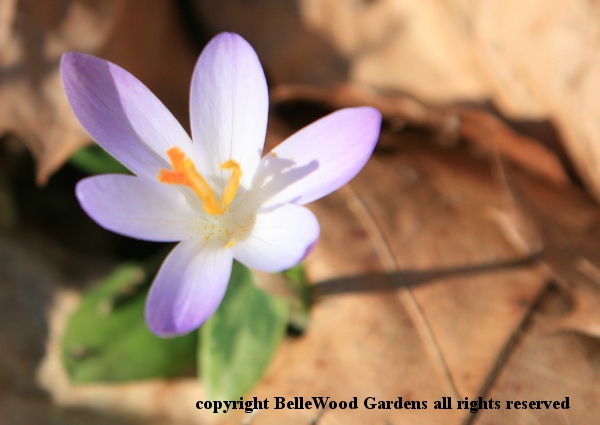
And the first crocus are now blooming, Crocus tomasinnianus

More intensely colored Cyclamen coum is also in flower.
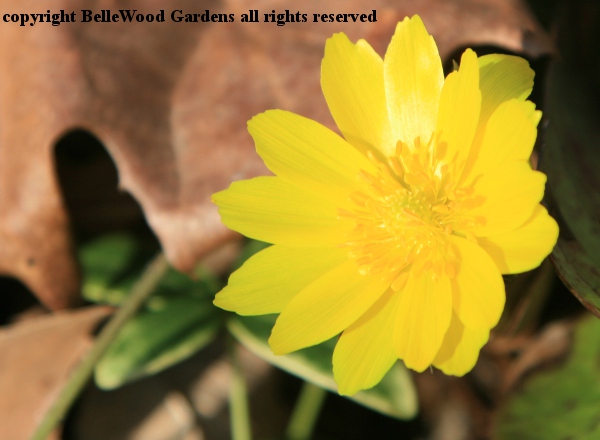
So too, the intense sun hued flowers of Adonis amurensis.
Sunday, 19 February 2017
Now that there have been two days of absurdly warm weather - 62 degrees Fahrenheit? In February? I mean, really now - regardless, the snow is melting and flowers are hurling themselves from the earth.
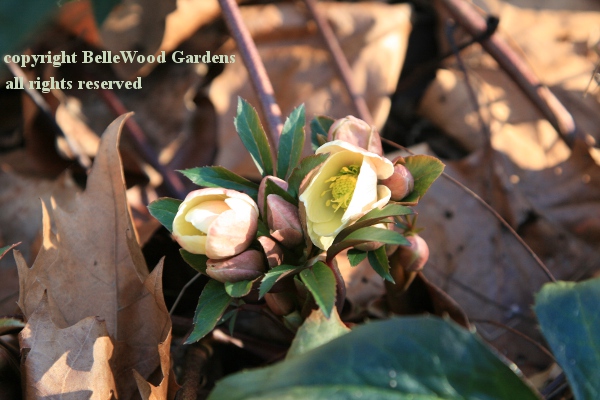
This hellebore has had a couple of name changes. No idea why. It used to be
Helleborus xericsmithii 'Winter's Song'. Nice name, don't you think.
Now you are likely to find it as Helleborus xballardiae 'HGC Joker'.
It is evergreen, with upright flowers flushed with rose on the back of the creamy white petals.

Another hellebore getting ready to open is
Helleborus niger, the so-called Christmas rose.
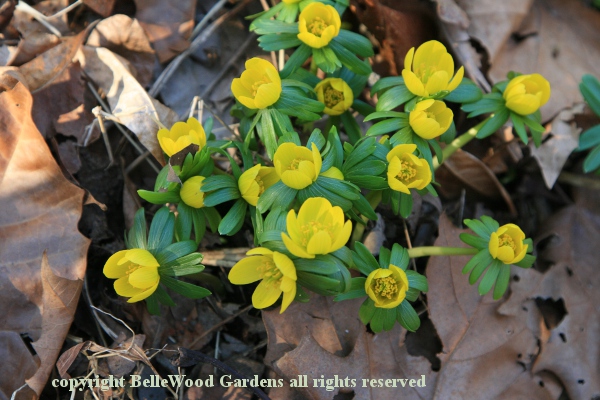
Winter aconites, Eranthis hyemalis are eagerly opening their golden flowers.

.

Another snowdrop is starting into bloom.
Galanthus ikariae with apple green leaves.
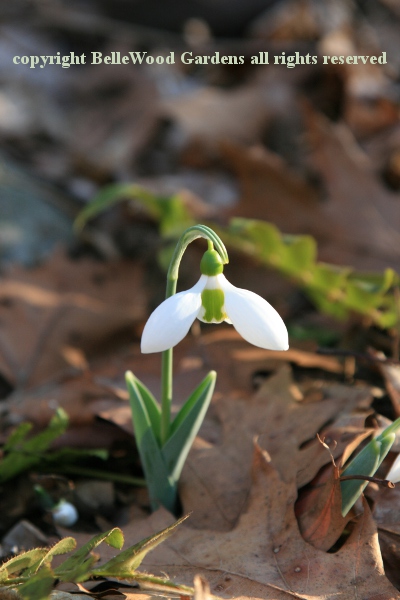
I am quite fond of Galanthus elwesii, with its
two green markings merged into one wide band.
Saturday, 11 February 2017
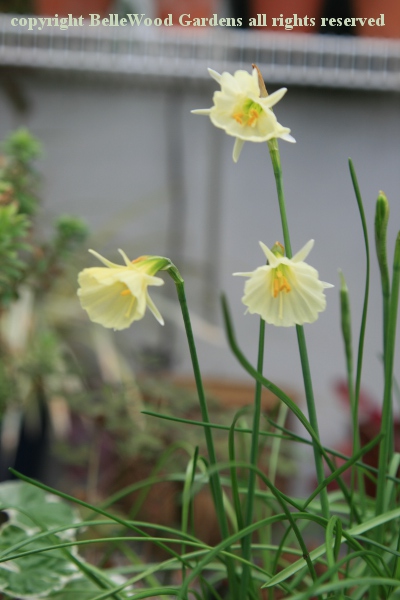
Yet another pretty little narcissus hybridized by Glenbrook Bulb Farm in Tasmania, and first flowered in 1987. Seed parent was N. bulbocodium subsp. bulbocodium var. conspicuus and the pollen parent was N. cantabricus subsp. cantabricus var. foliosus.
Wednesday, 8 February 2017
An absurdly warm day with a high of 58 degrees Fahrenheit. I opened windows to let some fresh air in. And went into the woods to see what might be showing in the garden.
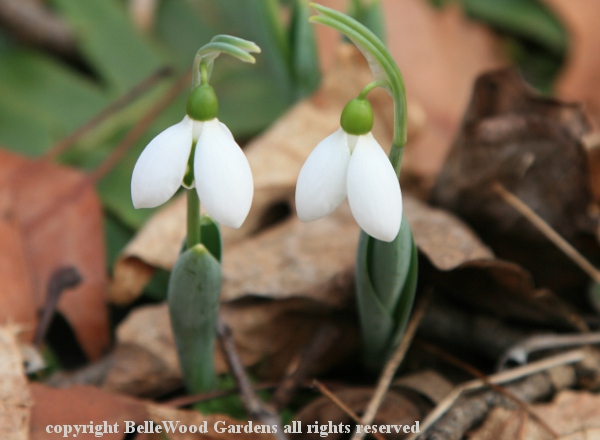
Galanthus elwesii several of them. Gently cupped, pristine white petals,
as rounded as a cream tea spoon. Several scattered here and there in the woods.

Winter aconites, Eranthis hyemalis, just beginning to make a show.
Two here and a few there, not yet open to their buttercup semblence.

An early hellebore, Helleborus Early Purple Group, the dark flowers
and purple stained foliage ( it looks so tender) just starting.
Sunday, 29 January 2017
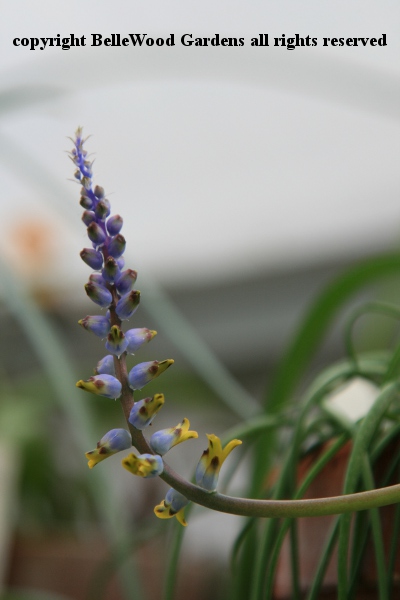
Native to the Cape of South Africa, lachenalia are wonderful little winter blooming bulbs, easily grown in cool conditions. They do well in my greenhouse, heated to 50 degrees Fahrenheit and reward the minimal care required with winter flowers. This is L. mutabilis.
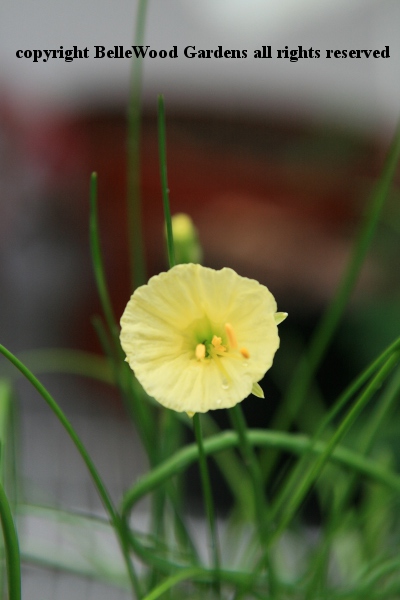
Another of the little hoop petticoat daffodils. This is 'Julia Jane', a 1966 selection by James Archibald from wild collected Narcissus romieuxii from Morocco and named for his daughter. Somewhat later flowering than Narcissus cantabricus and just as welcome.
Wednesday, 4 January 2017
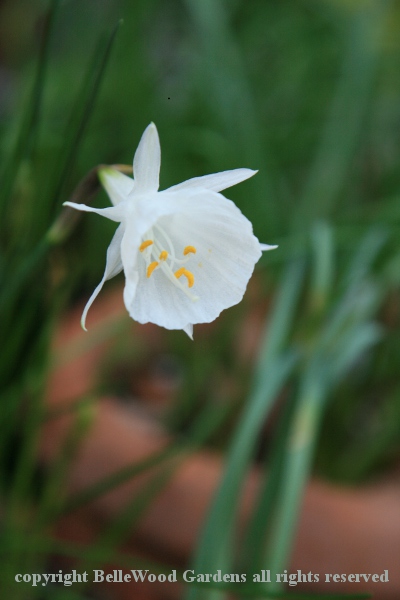
Narcissus cantabricus is one of the dainty little hoop petticoat daffodils. This flower is about the size of the first joint on my thumb. The species comes from southern Spain, the Balearic Islands, Algeria, and Morocco, and is extremely variable with several subspecies. Brightening up the short, dark days of winter in my cold greenhouse, the various forms flower from December through to February. Care is simple - start watering in September with occasional dilute fertilizer (something high in potash, low nitrogen at half strength every other week once the slender, almost grass-like foliage appears..) Feeding and watering should stop as the foliage dies back in May and the pots are allowed to dry out completely over the summer. I keep the pots plunged in sand, and occasionally moisten the sand near the clay pots. Repotting in a gritty, free draining soil mix is only necessary every few years.